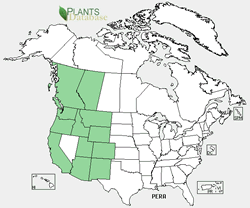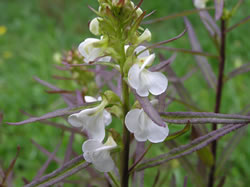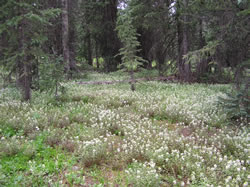Plant of the Week
 Pedicularis racemosa range map. USDA PLANTS Database.
Pedicularis racemosa range map. USDA PLANTS Database.
 Closeup of the white flowers and purplish leaves (bracts) of the inflorescence of Pedicularis racemosa. Photo by Al Schneider.
Closeup of the white flowers and purplish leaves (bracts) of the inflorescence of Pedicularis racemosa. Photo by Al Schneider.
 Thousands of Pedicularis racemosa flowers whiten a subalpine Engelmann spruce woods. Photo by Al Schneider.
Thousands of Pedicularis racemosa flowers whiten a subalpine Engelmann spruce woods. Photo by Al Schneider.
Leafy lousewort (Pedicularis racemosa)
By Walter Fertig
In medieval times, many plants were given names based on their uses or properties, both real and imagined. Lousewort (Pedicularis) got its name because of the belief that livestock grazing on the plant would get lice (and possibly transmit them to humans). There seems to be little evidence to support this claim, but it did not prevent Linnaeus from using the Latin word Pediculus (louse) for the plant’s genus name.
Nearly 500 species of Pedicularis are known from areas with mostly cool or temperate climates in the Northern Hemisphere (especially China) and the South American Andes. About 40 species occur in North America, including the widespread Leafy lousewort (P. racemosa). This species has narrow leaves with toothed margins and a loose cluster of bilaterally symmetrical flowers with a broad, three-lobed lower lip and a strongly curved upper lip (called a galea). The stout, beak-like appearance of the flower inspired another common name: parrot’s beak. Pedicularis racemosa comes in two color phases. White flowered plants (var. alba) are the predominant form in the Rocky Mountains from British Columbia and Alberta to Arizona and New Mexico. Plants from the Cascades and Sierra Nevada have pink flowers and are called var. racemosa. The unusually shaped flowers are an adaptation to pollination by bumblebees.
Traditionally, Pedicularis has been included in the figwort family (Scrophulariaceae). Louseworts have green leaves and produce their own food through normal photosynthesis but also have roots capable of capturing nutrients and water from adjacent plants making them partially parasitic (or hemiparasites). Recent genetic studies have shown that Pedicularis and other hemiparasitic genera in the Scrophulariaceae (including the Indian paintbrushes, Castilleja) are better placed in the broomrape family (Orobanchaceae) with species that are true parasites that lack green chlorophyll.
Another recent discovery implicates Leafy lousewort as an alternate host for White pine blister rust. An introduced fungus called Cronartium ribicola causes this infectious disease of five-needled pines. When it first arrived in North America from Europe, White pine blister rust was thought to only utilize gooseberries (genus Ribes of the family Grossulariaceae) as an alternate host in its complicated life cycle. Foresters once waged war to remove gooseberries from pine forests in the west in a fruitless effort to stem the spread of the disease. Infected pines produce resinous lesions that eventually girdle the trunk and cut off flow of water and nutrients. The disease has spread widely across western North America in the last century, greatly reducing the abundance of western white pine (Pinus monticola), and more recently has been implicated in declines of Limber pine (P. flexilis) and Bristlecone pine (P. aristata). It remains unknown whether Leafy lousewort has served as an alternate host for blister rust for decades, or if this relationship has evolved only recently.


